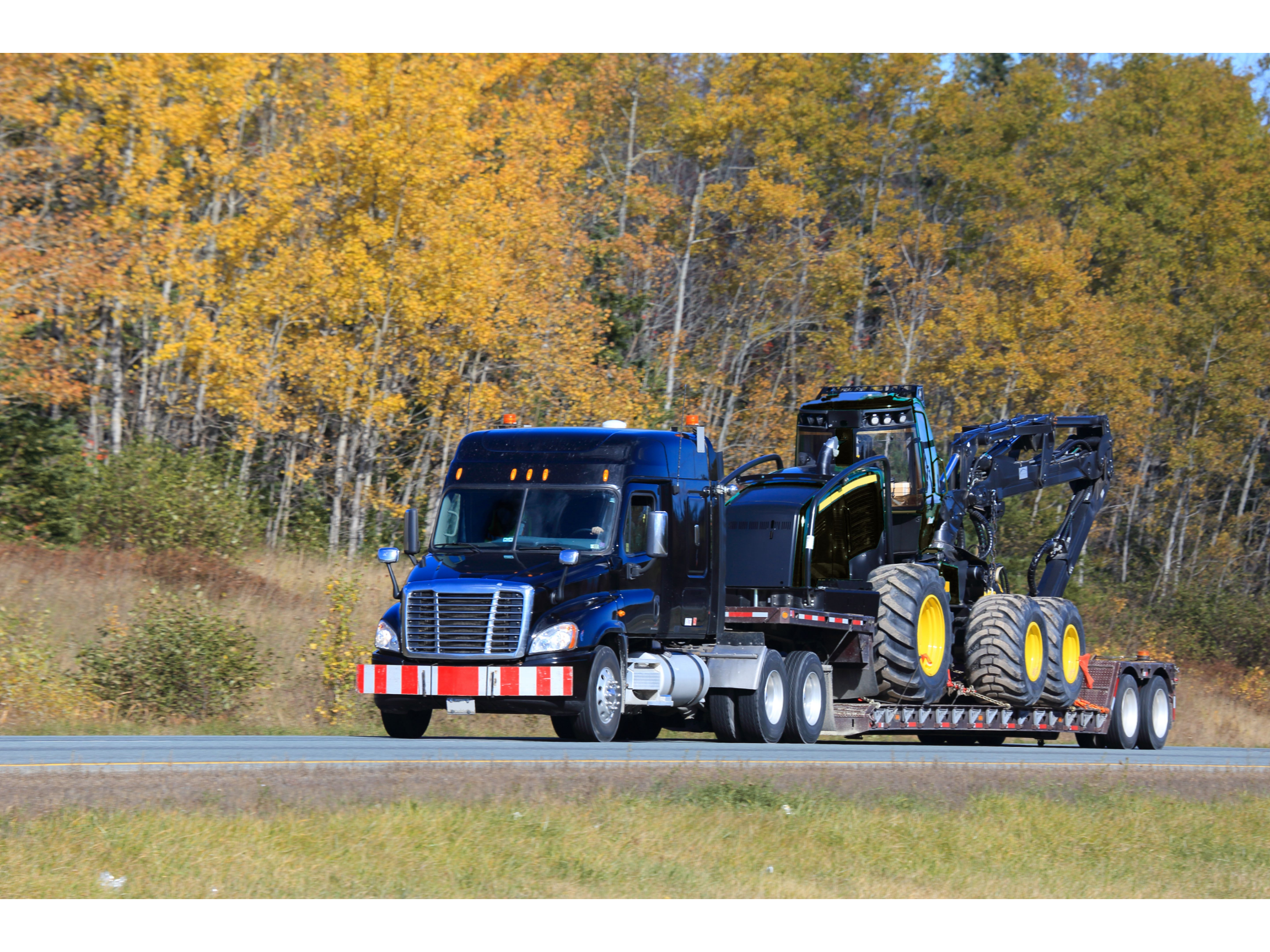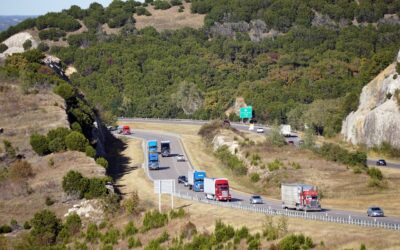Summary: Heavy hauling and oversized load transport requires serious planning to ensure safety measures are met at every step of the way. We’re sharing five of our top tips to help you see your shipment transport safely and securely whether this is your first time shipping or you do so on a regular basis.
Inside this article:
- Tip 1: Choosing your shipment dates
- Tip 2: Accurately measuring your load
- Tip 3: Hiring a professional heavy hauler
- Tip 4: Getting ready for pick-up day
- Tip 5: Communicating with your driver
- Bonus tips on heavy hauling and how to find the right heavy haul transportation service
Why Safety Matters in Heavy Equipment Transport
Heavy and specialized equipment is not only massive and difficult to move, but it’s also valuable. The last thing you want is to rush your heavy haul, hire an amateur, or cut corners on measurement and permits. Not only could skipping steps result in legal fines but it could also lead to preventable accidents and damage to your valuable machines.
It’s no secret that heavy hauling requires careful planning. There are many factors to plan, details to arrange, and a certain amount of flexibility required when booking dates and a driver. Rather than let you discover the pitfalls of heavy equipment transport on your own, we’ve compiled our top five tips to help you plan your next heavy haul while keeping safety as a top priority.
1. Choose a Range of Possible Dates
As we hinted above, booking a rigid date for your heavy haul shipment is not always the wisest move. Why? Well, when it comes to moving large pieces of machinery, there are certain restrictions that other vehicles do not have. Local regulations often restrict when large loads can be on public roads. They also assign particular routes to large loads, and factors such as road construction, weather, and environmental elements (unexpected flooding, fires, or smoke) can prevent your shipment from moving on a certain date.
Weather and government regulations are the two main factors to consider when planning your shipment dates. You’ll need to find a day and time when the weather is not dangerous, and your load is allowed on the road—it’s usually best to avoid long weekends and peak traffic times. Working with a professional heavy haul trucking company or driver will allow you to consult an expert and get experienced advice on when to have your machine transported.
2. Get Accurate Dimensions of Your Load
The most vital piece of information required for transporting your heavy equipment is its size and weight. Not only does a driver need to know the dimensions in order to arrive with the right equipment, but you also need to know the dimensions to legally haul your machine. If you’re not sure how to find the measurements of your machine, you can start by using our powerful Specs Tool. It contains over 60,000 pre-loaded machines and their base dimensions. If you’ve added any custom parts or have attachments, you’ll need to account for those differences.
Oversize Permits Required
When loads are over the legal size limit in height, width, length, or weight, special permits are required before that load can move. These limitations are in place for several reasons, including the following:
- The maximum weight infrastructure can carry—think bridges and overpasses.
- The maximum height a route can accommodate—think tunnels, overpasses, bridges, and overhead signs.
- The maximum width depends on how many lanes a roadway has—narrow roads make it trickier to haul a wide load and often require pilot vehicles.
- The maximum length is usually a safety concern for other vehicles on the road—rules often require visible signage, red flags, and pilot vehicles.
Getting an Oversized Permit
Just because your load is oversized, it doesn’t mean you cannot haul it somewhere. It does mean that you need to prepare for your shipment well in advance to allow time to pull the appropriate permits. Your driver will need a permit for most oversized categories. Depending on how much over the limit your load is, you may also require signage on the truck, red flags on the oversized points, flashing lights, and possibly pilot or escort vehicles to help warn traffic of your shipment moving by and to help the truck navigate the route.
Preparing With the Right Equipment
Knowing the accurate dimensions of your load is also important for your driver so they arrive with the right size of trailer to fit the equipment as well as the correct number of axles or multi axle configurations to safely pull the load. Not using the right trailer can not only put your shipment in danger while on the road, but it can also cause damage to the driver’s truck.
3. Hire a Professional Heavy Haul Driver
After reading point #2, you’re likely not surprised that our tip #3 is to hire a professional heavy haul driver. The main benefit of hiring a professional is that you’ll have the expertise of someone who has hauled heavy loads before. They’ll have the right equipment, they’ll know what questions to ask, and you’ll have confidence that your equipment is in good hands.
If you know someone who is a professional driver and can transport your equipment for you, then you’re all set. However, if you’re like most people, you might not haul heavy equipment that often or all your contacts are busy with their normal shipments. That’s exactly why we created the Trusted Dispatch load board: to connect customers like you with professional, experienced heavy haul drivers.
How the Load Board Works
A load board functions in a very straightforward manner. You, the customer, have a heavy haul that needs a driver. Simply use our online platform to get yourself a free, instant quote based on the dimensions and the distance it needs to travel. Once you enter your pick-up location, your measurements, and your drop-off destination, you’ll get a free, instant estimate of the cost. It’s important to note that the quotes are based on a base rate. This means that if you have additional attachments to ship or your load is oversized and will require permits and an escort vehicle, or you require a long-haul shipment, your actual cost will be higher, depending on when a driver is available to you.
Once you save your quote and publish your load to the board, available drivers will be notified. Any driver who has the right equipment and is available on your preferred shipping dates will make an offer to haul your equipment. In the event that your load has additional costs associated with it, your driver may provide you with an all-in quote that would cover all the extra costs, so you won’t be surprised at the end with a list of additional charges.
To get your free, instant quote click here.
You Have the Freedom to Choose
As the customer, it is always within your power to accept a driver’s offer or not. Keep in mind that when you turn a driver down, you may have to wait longer for another driver to become available. Since we operate without brokers, there are no extra fees to use the Trusted Dispatch system. The starting quotes are fair prices for both you and the driver, and all-in offers are typically the fair rate plus the additional costs needed to make the load happen.
4. Prepare Your Pick-Up Location
Once you have found your driver, it’s time to prepare your equipment for transport. In addition to getting your equipment ready, it’s also important to prepare your pick-up location. Loading heavy equipment onto a lowboy trailer requires space to maneuver. We recommend clearing away everything that is mobile to allow plenty of space. If your driveway is full of parked vehicles, relocate those on moving day until the haul has left your property. If you’re hauling in the winter, ensure that the snow has been cleared away from the machine. Another factor to consider is parking the equipment on level ground to ensure safe loading procedures and no risk of tipping.
If you’re using our app for your heavy haul, you’ll already have provided the driver with your pick-up location. We recommend clearly marking your location, whether that is making sure the lights are on, your address is clearly visible, or you have a roadway marker for rural driveways. The last thing anyone wants is to waste time on pick-up day because your driver can’t find you.
5. Communicate With Your Driver
Communication makes everything in life easier, including heavy hauling. You’ll want to be in touch with your driver on the pick-up day to ensure they find your location easily, but it doesn’t stop there. Once your driver has loaded your machine, secured it to the trailer, and driven away, you’ll want to stay reachable during the transport. Even with careful preparation, unexpected events can happen. From construction to weather to mechanical issues, it’s always best to keep your phone on until your load has reached its destination safely.
Who Needs to Haul Heavy Equipment?
Various types of customers use our load board to find professional drivers for their heavy haul loads. Everyone from individual farmers to small construction companies to large equipment rental companies. Whether you need to move one piece of equipment, have routine shipments, or need to supplement your own heavy haul service, our driver network stretches across North America to accommodate many different routes.
The Top Pieces of Equipment We’ve Shipped
To see some of the heavy loads we’ve moved in the past, you can browse our “Drivers in Action” page where you’ll see a variety of equipment, including forestry machinery, construction equipment, farm equipment, along with various implements and attachments. If it’s a large, heavy load, our drivers are equipped to get it moved.
Industry Leaders in Heavy Equipment
The types of loads we see hit our load board depend on where the machine is headed. The Alberta to Texas corridor will see more oil, gas, and mining machines on the highways, whereas the mid-west USA and western provinces of Canada see farm equipment on low-deck trailers on a regular basis in the spring, summer, and fall months. Construction equipment might be spotted at any time of year, in any corner of North America. Everything from excavators to graders to front loaders to combines and seeders—the drivers that use the Trusted Dispatch load board have hauled it all.
Have More Questions? We Can Help!
While we’ve covered the primary questions regarding safety while hauling heavy equipment, you may have more concerns. Our blog provides extensive coverage on all topics related to heavy equipment transport. We also provide exceptional customer service.
Heavy Haul Company in North America
If you’re looking for heavy haul transport in Canada, the United States, or anywhere in between, Trusted Dispatch makes hauling loads simple. Get started with your free, instant quote today.





